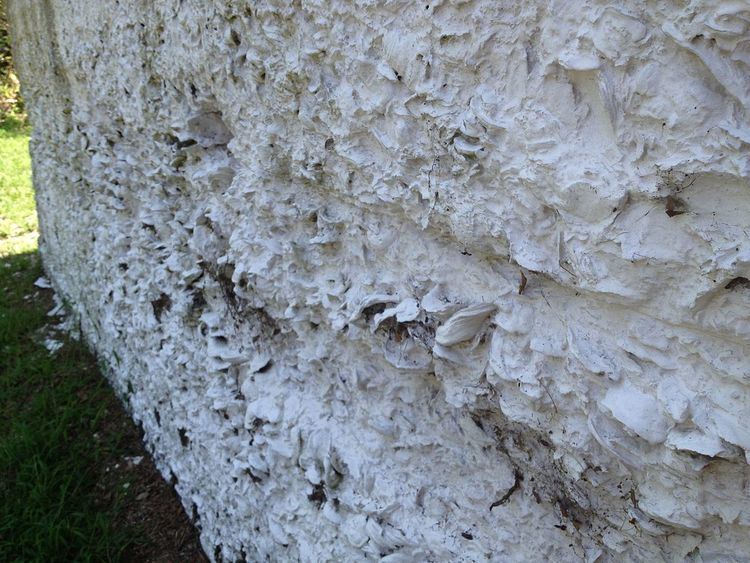 | ||
Tabby is a type of concrete made by burning oyster shells to create lime, then mixing it with water, sand, ash and broken oyster shells. Tabby was used by early Spanish settlers in present-day North Carolina and Florida, then by English colonists primarily in coastal South Carolina and Georgia.
Contents
Revivals in the use of tabby spread northward and continued into the early 19th century. Tabby was normally protected with a coating of plaster or stucco.
Origin
Tabby's origin is uncertain. There is evidence that North African Moors brought a predecessor form of tabby to Spain when they invaded that kingdom: a form of tabby is used in Morocco today and some tabby structures survive in Spain, though in both instances the aggregate is granite, not oyster shells.
It is likely that 16th-century Spanish explorers first brought tabby (which appears as "tabee", "tapis", "tappy" and "tapia" in early documents) to the coast of Florida in the sixteenth century. Tapia is Spanish for "mud wall" and Arabic tabbi means a mixture of mortar and lime or African tabi. In fact, the mortar used to chink the earliest cabins in this area was a mixture of mud and Spanish moss.
Some researchers believe that English colonists developed their own process independently of the Spanish.
James Oglethorpe is credited with introducing "Oglethorpe tabby" into Georgia after seeing Spanish forts in Florida and encouraging its use, using it himself for his house near Fort Frederica. Later Thomas Spalding, who had grown up in Oglethorpe's house, led a tabby revival in the second quarter of the 19th century sometimes referred to as "Spalding tabby". Another revival occurred with the development of Jekyll Island in the 1880s.
Regions of use
Limestone to make building lime was not available to early settlers so lime was imported or made from oyster shells. Shell middens along the coast proved to be a supply of shells to make tabby which diffused from two primary centers or hearths: one at Saint Augustine, Florida, and the other at Beaufort, South Carolina.
The earliest known use of tabby was near Beaufort, South Carolina area, formerly known as Santa Elena which was the capital of Spanish Florida from 1566 to 1587.
The British tradition began later (some time close to, but earlier than, 1700, upon introduction of the techniques from Spanish Florida) than the Spanish (1580), and spread far more widely as a building material, reaching at least as far north as Staten Island, New York, where it can be found in the still-standing Abraham Manee House, erected around 1670. Beaufort, South Carolina, was both the primary center for British tabby and the location of the earliest British tabby in the southeastern United States. It was here that the British tradition first developed, and from this hearth tabby eventually spread throughout the sea island district.
Process
The labor-intensive process depended on slave labor to crush and burn the oyster shells into quicklime. The quicklime was then slaked (hydrated), combined with the shells, sand and water then poured or tamped into wood forms called cradles, built up in layers in a similar manner to rammed earth. Tabby was used as a substitute for bricks, which were rare and expensive because of the absence of local clay.
Tabby was used like concrete for floors, foundations, columns, roofs or was made into bricks or used as "oyster shell mortar" or "burnt shell mortar".
